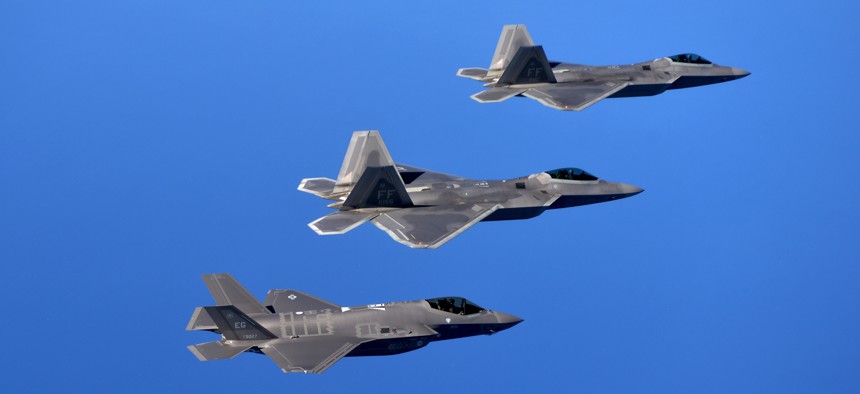
F-22 Raptors from the 94th Fighter Squadron and F-35A Lightning IIs fly in formation after completing a training mission. U.S. Air Force photo by Master Sgt. Shane A. Cuomo
Skunk Works Chief: How To Keep America’s Airborne Advantage
Regular updates to the F-22 and F-35, says Lockheed’s Weiss, plus a deep commitment to chasing the game-changing tech of the future.
Can China’s and Russia’s new fifth-generation warplanes and surface-to-air missiles threaten the American military’s dominance of the skies? Not yet, says one man whose job it is to make sure that remains the case for decades to come.
“We still today have a distinct advantage with our fifth-generation airplanes versus the capabilities that our adversaries are developing,” said Rob Weiss, executive vice president and general manager of Lockheed Martin’s Advanced Development Programs — better known as the Skunk Works.
The secretive organization that built the famed U-2 spy plane, SR-71 Blackbird, and F-117 attack jet is now sifting through technologies — whether existing, under development, or barely envisioned — that might be needed to replace today’s fifth-generation F-22 and F-35 stealth fighters. But Weiss says such replacements aren’t needed anytime soon — and perhaps not for another three decades.
“We’ve done this analysis for more than a decade now and it’s clear that the fifth-[generation F-22s and F-35s] are very capable versus a threat and substantially more capable than any fourth-generation airplane,” he told a small group of reporters Tuesday.
Still, today’s warplanes will require incremental modifications over coming years to keep their edge, Weiss said. China and Russia are “going to get better,” he said. “Therefore, we need to be on this modernization roadmap for the F-22 and the F-35 to be able to maintain that capability gap versus the threat systems.”
China has stirred up aviation watchers in recent years by producing two aircraft, the J-20 and the J-31, that largely resemble the F-22 and F-35 respectively. Military experts say the resemblance is merely skin-deep. The guts of those copycat planes — the sensors and other high-tech electronics, and high-performance engines — are inferior to the U.S. originals.
Still, Weiss said his reaction to the speed at which China and Russia have built fifth-generation planes is “Probably expected, to a little bit surprising.”
“The biggest issue is they’re inside our cycle time of, basically, design-build-test-learn-cycle it back into the next system,” he said. “We used to do that in the United States.”
Weiss pointed to how quickly the military developed planes in the 1940s, 1950s, and 1960s.
“We need to get back into that cycle of not necessarily developing airplanes, but testing the technology,” he said.
But the Pentagon should not rush to build a new plane with immature technology, Weiss said.
“There’s, in our view, little point in developing a new airplane that doesn’t do anything more than what you can do as you modernize F-22s and F-35s,” he said.
But the Pentagon should invest in “truly game-changing technologies and capabilities that need to be matured so that a decade or more from now” that will one day be part of a so-called sixth-generation fighter jet.




